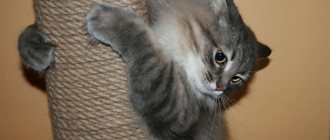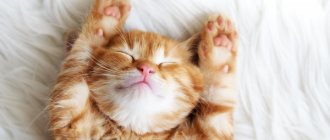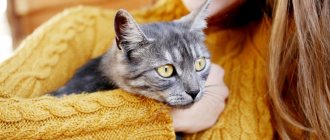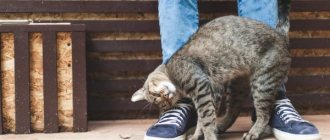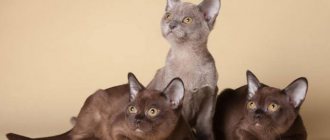Slavic legends about cats
Our ancestors considered the cat to be the animal of Veles, the god of cattle, agriculture and poetry. That's why we all know Kot-Bayun - a huge monster that sits on an iron pole and lulls heroes to sleep with its tales, and then eats them. However, Bayun could be caught and tamed, then his tales became therapeutic for the owner.
In addition, cats in Slavic mythology have always been associated with the brownie and the ovinnik; both guardians could turn into cats or communicate with him. Both also loved milk, which cats willingly shared with them, preferring mice.
In Bazhov's tales, which preserved the Ural factory legends for us, the Earthen Cat is often mentioned. In the Urals it was believed that this beast lived underground, and only its red, fiery ears stuck out above the ground. Wherever such ears appear, the treasure is buried there. And this belief appeared, apparently, thanks to the sulfurous lights escaping from the mountain voids.
Scandinavian legends about cats
According to the Scandinavian Eddas, cats are the companions of the goddess Freya, the second oldest and most beautiful goddess of Asgard. The beautiful Freya, leader of the Valkyries, patroness of fairies and elves, loved to ride around the sky in a chariot drawn by two cats. These cats looked like lynxes - large, furry and with tufts on their ears. Apparently, their descendants became the Norwegian forest cats - the national treasure of Norway.
In Iceland in the 19th century, a special legend about the terrible Yule cat appeared. This is a huge cat who lives with a cannibal who kidnaps lazy children. The Yule cat operates during Christmas time (Yule), eating anyone who has not managed to acquire a woolen new thing by this time. The legend was invented by parents so that their children would help them more actively in working with sheep and their wool - the main source of income for Icelanders.
Celtic legends about cats
The Shea Cat, found in Scottish and Irish legends, is a large black animal with a white spot on its chest. Apparently, myths about him appeared thanks to the Kellas cats - semi-mythical hybrids of local forest cats and domestic cats brought to the world by Roman legionnaires. Shi cat is neither evil nor good. He can steal the souls of the dead before they are buried, or he can bless the house where he was fed milk on Samhain. According to another version, Shi Cat is a werewolf witch; she can only take off the form of an animal 8 times. If he turns into a cat in the 9th, he will take on this image forever. This is probably why we believe that a cat has 9 lives.
Another mythical Irish cat is Irusan, the king of cats. Irusan once attempted to kill a famous minstrel, but Saint Ciaran threw a red-hot rod at the cat, killed him and saved the poet.
The Welsh triads preserved stories about Shapalu or Kota Paluga - a terrible beast who, with its enormous claws, terrified settlements and devastated crops. This cat was given birth to the pig Henwen, who, fearing his evil, threw her offspring into the sea. But Palug survived because the peasants he had eaten when he grew up came out and picked him up. Only Sir Kay, one of the knights of the Round Table, was able to defeat the terrible cat.
The goddess Caridwen, the goddess of rebirth, transformation and inspiration, also lived in Wales. White cats served Caridwen - they transmitted her orders to the ground.
The British, among whom there were so many sailors and fishermen, had a legend about a sea cat. She definitely had to throw in some of the catch so she wouldn't get angry and cause a storm. The sea cat is a witch who once went on a boat with her fisherman fiancé. One of the sailors suggested throwing her overboard, since being a woman on the ship was not good. The witch got angry, summoned a storm that scattered all the ships and killed all the fishermen, and then nevertheless jumped into the sea, but this time herself and in the form of a cat.
They live in the sea and cause storms
Superstitious British fishermen throw a small portion of their catch back into the sea to please the cat. According to legend, this cat living in the sea was once a woman who practiced magic. She went sailing with her husband. During the voyage, the husband's comrades decided to drown the witch, because it was unlucky for a woman to be on board. It turned out that the woman was overboard - to even greater misfortune. The witch got angry and caused a storm that sank not only the ship with the sailors who drowned her, but the entire flotilla. Since then, the witch has lived in the sea in the form of a four-eyed cat.
Legends about Basque cats
In northern Spain and southern France, the Basques and neighboring peoples believe in the wonderful cat Matagot. Matagot is an evil creature that appears in the guise of a black cat. Actually, it eats Christians, but if you catch it, you can ensure a comfortable existence for yourself. You should lure the matagot with a fish or chicken, grab it and run home without turning around. And then you need to give him the first bite of every dish and the first sip of every drink and receive for this a gold coin a day. Just remember to release the matagot when you become rich enough, otherwise you will die long and painfully until you give the creature freedom.
By the way, it was probably the matagot that was the prototype of the famous Puss in Boots.
Basque legends
The prototype of the famous character from the fairy tales of Charles Perrault is the Basque matagot, who eats Christians. The peoples who lived in the south of France and the north of Spain believed that if you catch this evil black creature, you can live without knowing troubles and sorrows for the rest of your life. You need to lure the cat with some kind of treat, manage to grab it and run at full speed without turning around.
Every morning, the matagot must be the first to taste the cooked food and drink a sip of wine. For this, the owners will receive a gold coin from him. But when a person becomes rich, he must definitely release the cat into the wild, otherwise the creature suffering in captivity will send illness and death to him.
INTERESTING TO FIND OUT: What does the Egyptian goddess with the head of a cat mean?
Greek legends about cats
The supreme Greek god Zeus loved women very much and did not miss a single skirt. One of his chosen ones was Queen Alcmene, who bore the god a son, Hercules. However, Hercules was born for seven whole days, because Hera forced the midwife goddess Lucina to delay the birth of Alcmene. The jealous wife of Zeus wanted Hercules' cousin to be born first in the Perseus dynasty, so that the throne would not go to the divine bastard. But one of Alcmene’s maids, the red-haired Galanthida, told Lucina that the son of Zeus had already been born, despite all her efforts to prevent this. The goddess fell for it and allowed Alcmene to be relieved of her burden for real. In revenge, the angry Hera turned Galanfida into a cat and exiled her to the underworld to live alone. But cats are cute, and Hecate, the patroness of witches, healers and crossroads, took pity on the former servant, and so the cat became involved in witchcraft. uh
The Greeks also had another cat goddess - Ailuros (Eiluros), as they called the Egyptian Bast, but they identified her with the Moon, and, therefore, considered her the nocturnal incarnation of Artemis. In one myth, Artemis even turns into a cat to escape from the Titan Typhon. The name of the goddess Eiluros gave the name to the fear of cats - eilurophobia.
Egyptian legends about cats
Today it is known for certain that cats were not domesticated in Egypt, but a little to the east - in the Fertile Crescent (from Mesopotamia to Anatolia). But only in the land of pyramids did these cute animals gain such impressive popularity. Of course, the main cat deity in Egypt was Bast, the patroness of women and the hearth. In addition, Bast was responsible for fertility and obstetrics, since cats have always been famous for their fertility and developed maternal instinct.
Also, the god Ra had a cat who helped him in the fight against the serpent Apep, so the cat in Egypt was associated with the sun, and its eyes, adjusting to the light, often served as a sundial.
Cult of the cat in ancient Egypt
Scientists believe that the first domestic cats appeared on the territory of Ancient Egypt. The Egyptians revered them and put them on a par with the gods. They believed that these animals were of divine origin.
Cat mummies.
According to records in manuscripts, temples were built in honor of cats. After death, they were embalmed and mummified. Archaeologists have found many similar mummies in the pyramids.
According to legend, cats were given to Egypt by the gods from Sirius. The priests believed that there was a whole civilization of creatures similar to domestic cats. These are highly spiritual beings close to the gods from Egyptian mythology. Perhaps they meant a parallel world or another planet.
It is no coincidence that the goddess Bast was depicted as a woman with the head of a cat. The Book of the Dead, found in Egypt, indicates that the cat is one of the forms of the god Ra. The cat creatures did not have a physical body and appeared to the priests in the form of translucent ghosts. They have two appearances - cat and human.
Legends say that cats conveyed the requests of the priests to the gods. Therefore, the attitude towards them developed accordingly. Cats were surrounded with luxury and were not driven out of churches during the sacraments, because this way the gods would hear prayers and answer them.
Found mummy of a cat in a tomb.
In Ancient Egypt, cats had access to pyramids and temple premises where priests were not allowed. There was no restriction on freedom; the cat could go wherever he wanted. Every temple had at least one cat.
During excavations in Egypt, small palaces were found; they were clearly not intended for people. Scientists have concluded: palaces were built for the cats of rich people. Only they had the right to have this animal in Ancient Egypt.
Not only legends and religious views became the reason for such veneration of cats in Egypt. These are also useful animals on the farm. They protected warehouses and barns, houses and temples from rats and mice.
When a cat died, mourning was observed for it, as for a deceased relative. Killing a cat living in a temple or palace was punishable by execution. A street woman was killed - the accused was sentenced to corporal punishment, a fine and general contempt. In 60 BC, Ptolemy banned executions for killing cats.
There were also cat cemeteries. The pharaoh's pets were mummified and buried next to him. The cat cult continued until 390 AD, after which the governors of Byzantium outlawed it.
Legends about Persian cats
In Persia (Iran) there are two legends about the origin of cats. The first is related to the saying “A lion sneezed and a cat was born.” One of the Persian historians wrote that the Creator, when creating the earth, forgot about cats, but did not forget about mice. The problem of lack of balance was clearly manifested in Noah's ark: mice multiplied during the journey and began to threaten the supplies designed for everyone. Then Noah asked the lion to sneeze, he obeyed and sneezed the cat. Stocks were saved.
Another Persian myth about cats is more ancient. One day, the hero Rustam, the hero of the Shahnameh epic, saved a magician from bandits. The magician, in gratitude, invited the hero to his tent and asked what to give him. Rustam was modest and said that he already had everything: the warmth of the fire, the pleasant smell of smoke and the starry sky above his head. Then the magician mixed smoke, fire and stars and handed Rustam a warm, smoky kitten, whose eyes shone like stars. This was probably the ancestor of the famous Persian breed.
Myths and legends.
A book about cats, Stefano Salviati “100 legendary cats.” Abridged version. Year of manufacture: 2008
Contents of the book - Click here.
1 part. Gods and magicians. (continued)
To fall on all fours. Muezza.
In the Islamic religion, in comparison with Christianity and Judaism, they have always treated cats, cats and kittens with respect. Unlike its well-known competitors dogs, the cat was not considered an unclean animal by Muslims; and she was even endowed with “baraka,” that is, according to Muslim beliefs, the ability to bring happiness. In the east, any true believer considers it necessary to feed any homeless feline. And the thought never even crosses his mind to offend or hit this animal. And even more so if the cat is black. Who can know? And if this is not a cat at all, but a cunning genie who has taken the shape of a cat in order to come to a criminal or sinner and cruelly torture and punish them. An example of their veneration in ancient times is the documentary records of ancient historians, philosophers and scientists. For example, Pliny the Younger notes that the Arabs greatly revered a gold statue depicting a cat, which was located in the city of Kaddista, and six centuries later the father of all believers, the great prophet Mohammed himself, showed great respect to cats? There is a legend that the prophet Mohammed (about 570 - 632) had a favorite cat called Muezza. She was very attached to Mohammed, she never left his side and loved to sleep on his simple robe. And then one day the prophet had to go to the mosque for general prayer. But, not wanting to disturb his pet, he simply took and tore the hem off the robe. The Muezza cat, in turn, entertained and amused its owner, performing various funny “curtsies” for him.
In gratitude, Mohammed ran his hand along her spine three times, and with this tenderness he gave her the ability to always land on her four paws when she fell. And to this day all the cats in the world can do this. For a true Muslim, feeding a stray cat, moreover, if it turns out to be blind, is a real duty, and those who do not fulfill it are condemned. No one in the east would think of killing a cat. According to existing beliefs, the cat may turn out to be not a cat, but a genie, who took on such a guise in order to come to sinners, to torment and torment them. In his essay “Cats,” Chanfleury reports that in the 13th century, one Cairo sultan, named El Daher-Baibars, bequeathed his entire garden to the stray cats living in it. And besides this, he also left a decent amount of money to support and feed the cat family to the full.
Cat from heaven.
When God the Father expelled Adam and Eve, as well as all their offspring from paradise, he brought the darkest night to earth. Neither the light of the moon nor the shine of the stars could break through this darkness. And then he sent a strong wind, which forced all people and animals to run further and further from paradise. The day after the cataclysm, everyone grieved and mourned their bitter fate. Young Jacob, the third son of Adam, was sad and upset more than anyone else. But, seeing his grief and confusion, the cat came up to him and calmed him down. Then, when Jacob wiped away his tears, he ordered him to cut a staff out of a stick for walking and get ready for a long journey. The cat explained to him that he perfectly remembers the road to paradise and, moreover, sees perfectly in the darkness. So, Jacob and the wise cat went to look for Eden. The boy and the cat walked for many days. They had to cross the desert, where they would certainly have died of hunger if the kind hedgehog had not brought them water and food. And so, unexpectedly, Jacob’s staff began to swell with spring buds, and then began to bloom! Without a doubt, this indicated that the gates of heaven were already nearby. God appointed a fiery angel to guard the gates of heaven, and no one was allowed to enter Eden. But, touched by the courage of the cat and the child, the angel allowed them to enter the Garden of Eden for one hour. Where they were allowed to pick one fruit each from all the trees. A. They were also given the ability to tell the eldest of their generation the way to heaven. So it turns out that even now there is one cat and one person living on earth who know the way to Eden. As for the plant that we call “Jacob’s staff,” it comes from the same walking stick that the son of Adam and Eve, by order of an angel, stuck into the ground near the gates of heaven. (This story, heard from the shepherds of the department of Creuse, was recorded by Roger Laufer.)
Cat and cat from Noah's Ark.
Not many animals, except cats, have received so many legends telling about how their kind appeared on earth. There is even a version that they were even among those who survived the death of Atlantis, that continent that disappeared as a result of the catastrophe, the existence of which Plato insisted on. In his Persian Letters, Montesquet cites an equally poetic oriental legend. It is well known that on the eve of the Flood, by order of God, Noah loaded into the ark a pair of animals from among the inhabitants of the earth and air. There were no cats in the world back then. During the forty-day voyage, certain problems arose on the ship: the lions were especially irritated by the insolent rats, which had already multiplied and depleted food supplies. Puzzled, Noah turned to God the Father, who then ordered him to pass his hand in front of the lion’s nostrils. Noah did just that. The majestic lion felt a strong tightness in his chest, then sneezed violently. From this sneezing, a cat and a cat appeared - the first of those who were not yet on the planet, and they immediately began to hunt for the annoying rats. In his “History of Cats” (1727), Moncrief gives another version of this story, which was told to him by a high-ranking mullah. He allegedly said that the animals of various species presented in the ark were not free from “outbursts of gallantry” (as it was called in the 18th century!) and some of them entered into unnatural relationships. So the monkey amused himself “by pestering the young lioness more than once”; and from their cupids a cat and a she-cat were born. Everyone believes in their own...
The cat is at the manger.
The Catholic religion never favored cats, and Provençal manufacturers of Christmas clay figurines never placed cats in mangers, while dogs and chickens, sheep and guinea fowl, pigs and pigeons, not to mention the camels of the Magi, and ox and donkey, were allowed into the manger. , called to warm the baby Jesus with their breath. This absence was most likely explained to the children by the fact that the cat was expelled from the nursery because of his love of catching birds, wasn’t it? This attitude seems to be in little agreement with the ideal of St. Francis of Assisi, to whom legend ascribes the first performance of the Christmas spectacle. Originating in Italy, the manger show became a popular spectacle and reached extreme sophistication, for example, in Genoa and especially in Naples. The Neapolitan manger, made in the 18th century, is not limited to depicting only the stable where the Virgin Mary gave birth to the savior; they bring the entire Neapolitan people onto the stage. Framed by ancient ruins, churches, taverns and markets, colorful crowds fill the streets and squares. Not only the most familiar animals, but also exotic species have citizenship rights. Silhouette of a cat near fishmongers and taverns: the cat is busy searching for food, more concerned with filling its stomach than with its presence near the newborn Christ. And only in the second half of the 20th century, when cats gained enormous popularity as pets and human companions, their tricks were forgiven: from now on, sculptors sculpt white and black cats, placing them every Christmas in a bestiary collected near the nursery.
Happiness at the wave of a paw.
Its pretty silhouette will certainly be noticed by you in shop windows and in front of the entrance to shopping and entertainment establishments or restaurants: maneki-neko is the national talisman of happiness in Japan, where this figurine depicting a sitting cat with a raised paw first appeared. The phrase "maneki-neko" means "inviting cat." After all, it is with this gesture that the cat begins to move, extending its paw to you. What if she raised her left paw? This promises you prosperity; if the cat raised its right paw, then you are guaranteed the highest happiness. The origin of the maneki-neko figurine is not entirely clear. It is reliably known that it is connected with a tragic love story that took place in ancient times in Tokyo, in the Yoshiwara entertainment district. O-Tsuna, the owner of the Golden Cat tea house, was in love with a certain Hashiro-Bei. The beauty needed money, and her lover brought a tidy sum to improve matters. But the money was stolen. Anguished that he could no longer help, Hashiro-Bei threw himself into the Sumida River and drowned. O-Tsuna, amazed by his action, followed him. The high reputation of the Golden Cat and the sentimental drama that took place there attracted many visitors. This is how the legend arose that the golden cat brings happiness. This may have been the first maneki-neko, but it is more likely that the history of the "inviting cat" is associated with the importation of cats into Japan from China. Did this happen in the 6th century, or most likely in 999, during the reign of Emperor Ichijo? Much later, during the era of the Tokugawa shoguns, when Tokyo was still called Edo, a stray cat appeared in front of the monks of a temple located in the west of the city. Gotokuji "Temple of Supreme Virtue" was very poor. However, Buddhist monks shared their food with a stray cat. And for good reason: it was a heavenly messenger who brought good luck to Gotokuji. Believers who visited the temple, in turn, made it a rule to bring a bunch of dried fish to the pilgrim cat. Since then, Gotokuzi has remained faithful to the spirit of the one who brought prosperity to the temple. Nowadays, the traditional religion of the Japanese state - Shintoism - is combined with the Buddhist origins of the temple, and a maneki-neko is located in the sanctuary near the Buddha statue. The "inviting cat" is depicted standing, with a pilgrim's staff in his paw and a bunch of dried fish at his side, wearing the spotless white pilgrim's robe. There are numerous maneki-neko in other poses on the walls here. Believers gather and pray in front of glass shelves, facing primarily towards the cemetery, which is adjacent to the temple. Hundreds of maneki-neko are lined up on the racks, as if in a parade, surrounded by sticks of incense. People come here to pray to both the spirit of dead cats and the spirit of missing children, since maneki-neko are called upon to protect children. There is a custom of bringing figurines with the image of a cat, which replenish this cohort, placed at the entrance to the cemetery. Since the 19th century (and perhaps already since the 18th century), various maneki-neko have been produced in Japan, which anyone can buy. Today they are made from porcelain, papier-mâché, plastic or metal. From miniature tokens to huge images intended for reputable international offices, white or black, and most often tricolor (in the form of a bobtail - a Japanese cat with a pompom tail) maneki-neko became a bridge that connected Japan with other countries. How can you refuse shelter under your roof to a cat who brings you good luck and happiness with such delicacy?
Four cats at a sabbath.
In medieval Europe, two nights a year were considered so dangerous that a good Christian was afraid to stick his nose out: the night from October 31 to November 1 - ancient Samhain, the holiday of the dead among the Celts, which the Irish later called Halloween. Well, especially the night from April 30 to May 1, which thrilled the entire population of the German lands - Walpurgis Night. At midnight, all the demons and witches gathered for the Sabbath, where the chariot of the goddess Freya appeared, drawn by a team of four magnificent white cats. In Scandinavian and Germanic mythology, Freya was considered the goddess of fertility. Her name is close to Frie, or Frigg, who was the wife of Odin and was considered the patroness of marital love, while Freya favored free relationships. According to one legend, Freya could not stand the long separation from her husband, who sailed overseas to distant lands, and found solace in a scandalous affair with the hero Ottar. This was enough to create a well-defined reputation for her, or at least turn her into a goddess to whom they appealed in the throes of passionate love, and into a goddess of fertility. Therefore, there is nothing strange in the fact that rumor made Freya the leader of the Sabbath on Walpurgis Night; One should not be surprised that she is accompanied by four cats, serving as the embodiment of voluptuousness and sexual desire, appropriate for satanic orgies on this night, cursed by Christians. But be that as it may, among the northern peoples, having a cat in the house was considered a guarantee of well-being in housekeeping...
"100 legendary cats." Read on page .back forward……………….contents of the book.
Go to Main page.
Chinese legends about cats
China had its own wild cats, and it seems they were domesticated there almost earlier than in Ancient Egypt. Therefore, the Chinese separated the domestic cat Mao and the forest cat Li.
The word "mao" consists of three characters that mean field, grass and monster, which is fair, because the cat protected the rice fields from mice and was a real monster for them. And “mao” is consonant with the Chinese word for “eighty,” which is why cats are often featured on greeting cards. According to one legend, Mao was bought by the sorcerer Miau-Kuau, who could resurrect the dead and heal people, so the cat became his companion. Also, the Chinese, like the Egyptians, determined time by cat's eyes.
Li was associated with the goddess Li Shou. When the gods created the earth, Li Shou volunteered to look after their creation. However, she wanted more to sleep under the cherry tree or play with flower petals than to watch what was happening. Then Li Shou refused both the position and the ability to speak, and proposed appointing a person in charge. However, man did not understand the gods, so Li Shou became the liaison between him and the creators.
There was also a cat goddess in China, Yifang Zhen, the leader of a legion of cats. However, besides this data, all that is known about her is that she and her legion fought for one of the ancient Chinese dynasties.
Legends about cats
And I salute you. Today we will talk about legends.
──────── • ✤ • ────────
Slavic legends about cats
Our ancestors considered the cat to be the animal of Veles, the god of cattle, agriculture and poetry. That's why we all know Kot-Bayun - a huge monster that sits on an iron pole and lulls heroes to sleep with its tales, and then eats them. However, Bayun could be caught and tamed, then his tales became therapeutic for the owner.
In addition, cats in Slavic mythology have always been associated with the brownie and the ovinnik; both guardians could turn into cats or communicate with him. Both also loved milk, which cats willingly shared with them, preferring mice.
In Bazhov's tales, which preserved the Ural factory legends for us, the Earthen Cat is often mentioned. In the Urals it was believed that this beast lived underground, and only its red, fiery ears stuck out above the ground. Wherever such ears appear, the treasure is buried there. And this belief appeared, apparently, thanks to the sulfurous lights escaping from the mountain voids.
──────── • ✤ • ────────
Scandinavian legends about cats
According to the Scandinavian Eddas, cats are the companions of the goddess Freya, the second oldest and most beautiful goddess of Asgard. The beautiful Freya, leader of the Valkyries, patroness of fairies and elves, loved to ride around the sky in a chariot drawn by two cats. These cats looked like lynxes - large, furry and with tufts on their ears. Apparently, their descendants became the Norwegian forest cats - the national treasure of Norway.
In Iceland in the 19th century, a special legend about the terrible Yule cat appeared. This is a huge cat who lives with a cannibal who kidnaps lazy children. The Yule cat operates during Christmas time (Yule), eating anyone who has not managed to acquire a woolen new thing by this time. The legend was invented by parents so that their children would help them more actively in working with sheep and their wool - the main source of income for Icelanders.
──────── • ✤ • ────────
Celtic legends about cats
The Shea Cat, found in Scottish and Irish legends, is a large black animal with a white spot on its chest. Apparently, myths about him appeared thanks to the Kellas cats - semi-mythical hybrids of local forest cats and domestic cats brought to the world by Roman legionnaires. Shi cat is neither evil nor good. He can steal the souls of the dead before they are buried, or he can bless the house where he was fed milk on Samhain. According to another version, Shi Cat is a werewolf witch; she can only take off the form of an animal 8 times. If he turns into a cat in the 9th, he will take on this image forever. This is probably why we believe that a cat has 9 lives.
Another mythical Irish cat is Irusan, the king of cats. Irusan once attempted to kill a famous minstrel, but Saint Ciaran threw a red-hot rod at the cat, killed him and saved the poet.
The Welsh triads preserved stories about Shapalu or Kota Paluga - a terrible beast who, with its enormous claws, terrified settlements and devastated crops. This cat was given birth to the pig Henwen, who, fearing his evil, threw her offspring into the sea. But Palug survived because the peasants he had eaten when he grew up came out and picked him up. Only Sir Kay, one of the knights of the Round Table, was able to defeat the terrible cat.
The goddess Caridwen, the goddess of rebirth, transformation and inspiration, also lived in Wales. White cats served Caridwen - they transmitted her orders to the ground.
The British, among whom there were so many sailors and fishermen, had a legend about a sea cat. She definitely had to throw in some of the catch so she wouldn't get angry and cause a storm. The sea cat is a witch who once went on a boat with her fisherman fiancé. One of the sailors suggested throwing her overboard, since being a woman on the ship was not good. The witch got angry, summoned a storm that scattered all the ships and killed all the fishermen, and then nevertheless jumped into the sea, but this time herself and in the form of a cat.
──────── • ✤ • ────────
Basque legends about cats
In northern Spain and southern France, the Basques and neighboring peoples believe in the wonderful cat Matagot. Matagot is an evil creature that appears in the guise of a black cat. Actually, it eats Christians, but if you catch it, you can ensure a comfortable existence for yourself. You should lure the matagot with a fish or chicken, grab it and run home without turning around. And then you need to give him the first bite of every dish and the first sip of every drink and receive for this a gold coin a day. Just remember to release the matagot when you become rich enough, otherwise you will die long and painfully until you give the creature freedom.
By the way, it was probably the matagot that was the prototype of the famous Puss in Boots.
──────── • ✤ • ────────
Greek legends about cats
The supreme Greek god Zeus loved women very much and did not miss a single skirt. One of his chosen ones was Queen Alcmene, who bore the god a son, Hercules. However, Hercules was born for seven whole days, because Hera forced the midwife goddess Lucina to delay the birth of Alcmene. The jealous wife of Zeus wanted Hercules' cousin to be born first in the Perseus dynasty, so that the throne would not go to the divine bastard. But one of Alcmene’s maids, the red-haired Galanthida, told Lucina that the son of Zeus had already been born, despite all her efforts to prevent this. The goddess fell for it and allowed Alcmene to be relieved of her burden for real. In revenge, the angry Hera turned Galanfida into a cat and exiled her to the underworld to live alone. But cats are cute, and Hecate, the patroness of witches, healers and crossroads, took pity on the former servant, and so the cat became involved in witchcraft.
The Greeks also had another cat goddess - Ailuros (Eiluros), as they called the Egyptian Bast, but they identified her with the Moon, and, therefore, considered her the nocturnal incarnation of Artemis. In one myth, Artemis even turns into a cat to escape from the Titan Typhon. The name of the goddess Eiluros gave the name to the fear of cats - eilurophobia.
──────── • ✤ • ────────
Roman legends about cats
The cat, which walks on its own, became the companion of the goddess of freedom – Libertas – among the Romans. Libertas was worshiped by freedmen, former slaves, and therefore the cat also appeared on the banner of Spartacus’s troops.
──────── • ✤ • ────────
Egyptian legends about cats
Today it is known for certain that cats were not domesticated in Egypt, but a little to the east - in the Fertile Crescent (from Mesopotamia to Anatolia). But only in the land of pyramids did these cute animals gain such impressive popularity. Of course, the main cat deity in Egypt was Bast, the patroness of women and the hearth. In addition, Bast was responsible for fertility and obstetrics, since cats have always been famous for their fertility and developed maternal instinct.
Also, the god Ra had a cat who helped him in the fight against the serpent Apep, so the cat in Egypt was associated with the sun, and its eyes, adjusting to the light, often served as a sundial.
──────── • ✤ • ────────
European legends about cats
Jews are a nomadic people of cattle breeders, so they did not often encounter cats. But among the Sephardic Jews there was a legend that Lilith (Adam’s first wife) turned into the demon cat El Brusha, who killed babies by drinking their blood.
──────── • ✤ • ────────
Persian legends about cats
In Persia (Iran) there are two legends about the origin of cats. The first is related to the saying “A lion sneezed and a cat was born.” One of the Persian historians wrote that the Creator, when creating the earth, forgot about cats, but did not forget about mice. The problem of lack of balance was clearly manifested in Noah's ark: mice multiplied during the journey and began to threaten the supplies designed for everyone. Then Noah asked the lion to sneeze, he obeyed and sneezed the cat. Stocks were saved.
Another Persian myth about cats is more ancient. One day, the hero Rustam, the hero of the Shahnameh epic, saved a magician from bandits. The magician, in gratitude, invited the hero to his tent and asked what to give him. Rustam was modest and said that he already had everything: the warmth of the fire, the pleasant smell of smoke and the starry sky above his head. Then the magician mixed smoke, fire and stars and handed Rustam a warm, smoky kitten, whose eyes shone like stars. This was probably the ancestor of the famous Persian breed.
──────── • ✤ • ────────
Indian legends about cats
The Indian goddess of childbirth and protector of children, Shastha, was often depicted with the head of a cat or riding a cat. Initially, Shashkhti was an evil demon who sent diseases to newborns and women in labor, but later it was from her that women began to ask for protection and pregnancy.
The main god of the Indian pantheon, the thunderer Indra, was no less loving than Zeus, and therefore came to his mistresses in the form of a cat in order to deceive their husbands and admirers.
──────── • ✤ • ────────
Chinese legends about cats
China had its own wild cats, and it seems they were domesticated there almost earlier than in Ancient Egypt. Therefore, the Chinese separated the domestic cat Mao and the forest cat Li.
The word "mao" consists of three characters that mean field, grass and monster, which is fair, because the cat protected the rice fields from mice and was a real monster for them. And “mao” is consonant with the Chinese word for “eighty,” which is why cats are often featured on greeting cards. According to one legend, Mao was bought by the sorcerer Miau-Kuau, who could resurrect the dead and heal people, so the cat became his companion. Also, the Chinese, like the Egyptians, determined time by cat's eyes.
Li was associated with the goddess Li Shou. When the gods created the earth, Li Shou volunteered to look after their creation. However, she wanted more to sleep under the cherry tree or play with flower petals than to watch what was happening. Then Li Shou refused both the position and the ability to speak, and proposed appointing a person in charge. However, man did not understand the gods, so Li Shou became the liaison between him and the creators.
There was also a cat goddess in China, Yifang Zhen, the leader of a legion of cats. However, besides this data, all that is known about her is that she and her legion fought for one of the ancient Chinese dynasties.
──────── • ✤ • ────────
Japanese legends about cats
The Japanese endowed many animals with magical abilities, and the cat did not escape this fate - it became a bakeneko werewolf. Any cat can become a bakeneko if it fulfills one of the following conditions: it weighs 1 kan (3.75 kg), has a long tail, or lives to be 13 years old. Moreover, long-tailed cats had a tail that forked, and they turned into “forked cats” - nekomata, a special separate type of bakeneko. According to legends, werecats could eat their owner and take his form or revive the dead by jumping over him. The bakeneko were also capable of creating ghostly fireballs and walking on two legs. Most often, cats are possessed by the spirits of dead women who want to take revenge on their husbands. This is probably why Japanese bobtails appeared in the land of the rising sun - cats of an elegant build, with short tails, almost incapable of becoming bakeneko.
But there is also a lucky cat in Japan - maneki-neko. The traditional maneki-neko is a figurine of a white cat with or without red and black spots, which holds one or two paws raised in a gesture of invitation (calling for money, clients, luck). Sometimes in the lowered paw of the talisman lies a gold coin worth 10 million ryo; even more often it is decorated with a breastplate similar to the breastplate of Buddha-Jizo, the patron saint of children and travelers. There are three versions of the appearance of maneki-neko. In the first, the cat began to invite guests to an abandoned monastery, and thanks to her, the monastery flourished again; in the second, a cat saved a highly qualified prostitute from a snake; in the third, she appeared in a dream to a poor housewife, who kicked her out, and advised her to sculpt cats out of clay, which ensured the old woman a comfortable old age. And Maneki-neko took the coin from the legend about a cat who stole two gold coins from his rich owner for his sick poor neighbor who fed the cat fish.
Another Japanese belief says that a white cat with a spot on its back is the transmigrated soul of a person, because such spots look like a kimono.
──────── • ✤ • ────────
Thai legends about cats
According to Thai beliefs, cats were possessed by the souls of the dead, so they were buried in crypts along with their owners, but so that the animals could get out. For the same reason, cats were often present at the coronations of the kings of Siam and the burial ceremonies of Buddhist teachers.
Thai and Siamese cats often have knots on their tails, now considered a breeding defect caused by inbreeding, but these cats used to be called "royal". The fact is that there is a legend about the royal daughters who strung their rings on the tails of their beloved pets while bathing. To prevent these rings from falling, the cats “grew” knots.
About 20 breeds of cats were known in Thailand, a book of poems was even written about them, and therefore legends here were formed not only about the well-known Siamese and Thais, but also about others - for example, about the Korats. Korats in the region where they come from regularly participate in rituals to bring rain and are considered a good wedding gift as they promote fertility.
──────── • ✤ • ────────
American Cat Legends
As already mentioned, domestic cats came to America late, but there were always wild cougars, jaguars, lynxes, etc., and therefore some of the beliefs about them were transferred to cats. So, in Northern Mexico and Arizona there is a legend about a cactus cat covered with thorns and making pulque vodka. Such a cat, if he makes pulque and gets drunk, will bring a lot of trouble to those who fall under his paw.
But in Nevada, a cat was once tried for killing a baby, this trial was associated with a legend brought by settlers from England - cats take the breath away from children. But most likely, big cats could actually crush weak children while sleeping together.
At the end of the 20th century in the USA, thanks to psychologist Paul Dame, William Briton and Dr. Wallace Syfe, a legend arose that cats, after death, end up on the magical Rainbow Bridge, where they live in warmth and care, waiting to meet their owners when they come. term.
Argentines also have their own legend; they believe that the mysterious Ombre Gatto (Shadow Cat) or Catman, a werecat who is not averse to attacking people, wanders the streets of cities.
──────── • ✤ • ────────
All legends agree on one thing: cats are amazing creatures, our guides to the other world. And I finished.
Legends about cats Japanese
The Japanese endowed many animals with magical abilities, and the cat did not escape this fate - it became a bakeneko werewolf. Any cat can become a bakeneko if it fulfills one of the following conditions: it weighs 1 kan (3.75 kg), has a long tail, or lives to be 13 years old. Moreover, long-tailed cats had a tail that forked, and they turned into “forked cats” - nekomata, a special separate type of bakeneko. According to legends, werecats could eat their owner and take his form or revive the dead by jumping over him. The bakeneko were also capable of creating ghostly fireballs and walking on two legs. Most often, cats are possessed by the spirits of dead women who want to take revenge on their husbands. This is probably why Japanese bobtails appeared in the land of the rising sun - cats of an elegant build, with short tails, almost incapable of becoming a bakeneko.
But there is also a lucky cat in Japan - maneki-neko. The traditional maneki-neko is a figurine of a white cat with or without red and black spots, which holds one or two paws raised in a gesture of invitation (calling for money, clients, luck). Sometimes in the lowered paw of the talisman lies a gold coin worth 10 million ryo; even more often it is decorated with a breastplate similar to the breastplate of Buddha-Jizo, the patron saint of children and travelers. There are three versions of the appearance of maneki-neko. In the first, the cat began to invite guests to an abandoned monastery, and thanks to her, the monastery flourished again; in the second, a cat saved a highly qualified prostitute from a snake; in the third, she appeared in a dream to a poor housewife, who kicked her out, and advised her to sculpt cats out of clay, which ensured the old woman a comfortable old age. And Maneki-neko took the coin from the legend about a cat who stole two gold coins from his rich owner for his sick poor neighbor who fed the cat fish.
Another Japanese belief says that a white cat with a spot on its back is the transmigrated soul of a person, because such spots look like a kimono.
Legends and myths about cats
According to the legends of ancient peoples, cats have nine lives. After the loss of their eighth life, cats have a maximum life-protective function. Kittens born to cats in their ninth life have the ability to anticipate and predict the degree of threat to life.
There is a legend that domestic cats close their eyes when they eat food and when they die, in the next world they are asked if the owner fed them, to which they answer that they did not see. Therefore, in Eastern philosophy there is a belief that when a person dies, he goes to the gates of heaven along the blade of a sword on which nine cats are sitting, personifying nine human sins. And if a person is sinful, then at least one of them can throw him off the sword. Cats are a kind of judges.
In Eastern philosophy, cats are a symbol of wisdom and peace. Black cats are perceived as intermediaries between the worlds of the living and the dead, who are capable of transmitting information both back and forth. Since ancient times, “in all fairy tales,” all witches had black cats, as the personification of a connection with the other world.
There are a number of signs that when a black cat crosses the road, it is bad luck. This is all not true. After all, what information we subconsciously reproduce is what the black cat transmits to the other world. Roughly speaking, we program ourselves for this or that situation. If, when we see a black cat, we think that he brings happiness, then there will be no troubles after he crosses the road, but on the contrary, there will be good.
However, the Druids perceived cats as unreliable creatures and therefore, when they planned any actions, the cats were told one thing, in the hope that they would convey information to the world of the dead, but the actions they took were completely opposite.
Women who consider themselves a cat doom themselves to loneliness, uncertainty, and misunderstanding from others, since a cat is associated as a creature walking on its own, that is, a creature with an independent character and a unique will.
As for modern times, in many cases cats have helped people overcome themselves and cure many diseases by taking them upon themselves.
Cats have black-and-white vision, they also navigate well at night and have the effect of night vision. Cats' whiskers and eyebrows are antennas for the perception of external information. If we cut off a cat's whiskers, we thereby doom him to a future life without sensory organs. If we cut off the eyebrows, then we doom the cat to further disorientation in space, since the cat orients itself in space not only with its ears and eyes, but also using the antennae of the eyebrows and whiskers.
Cats see mental and astral projection. That’s why a cat is always brought into a new home first. She orients herself not only in connection with the real world, but also with the other world.
There is a myth or belief that if a cat came into the house on its own, then you cannot kick it out; it will take good luck with it. Cats also have the ability to communicate with brownies.
In many families with small children, they usually have kittens and, growing up with children, cats contribute to the development of the child’s sixth sense, as well as kindness, affection, and love of nature.
You have to keep your ears open with these animals, but you can also count on their support.
Cool cats video:
Do you want your children to develop comprehensively even while playing? Pay attention to the unique magnetic construction set, which can be purchased at the magwis.ru store. A game for having fun, developing motor skills and imagination.
Legends about cats Thai
According to Thai beliefs, cats were possessed by the souls of the dead, so they were buried in crypts along with their owners, but so that the animals could get out. For the same reason, cats were often present at the coronations of the kings of Siam and the burial ceremonies of Buddhist teachers.
Thai and Siamese cats often have knots on their tails, now considered a breeding defect caused by inbreeding, but these cats used to be called "royal". The fact is that there is a legend about the royal daughters who strung their rings on the tails of their beloved pets while bathing. To prevent these rings from falling, the cats “grew” knots.
About 20 breeds of cats were known in Thailand, a book of poems was even written about them, and therefore legends here were formed not only about the well-known Siamese and Thais, but also about others - for example, about the Korats. Korats in the region where they come from regularly participate in rituals to bring rain and are considered a good wedding gift as they promote fertility.
Japanese cat for good luck
In Japan, domesticated felines are feared and respected. What causes fear? In the East, a cat is a creature that can contact evil spirits. Japanese folklore ascribes to him the abilities of an energy vampire. Cats control the desire to feed on other people's energy.
Maneki-neko.
The Japanese consider cats to be the patrons of merchants. In souvenir shops today there is Maneki-neko - the bringer of good luck, or money cat. This is a porcelain or ceramic figurine of a cat with its front paw raised vertically. Antique samples are made of stone.
Today, such lucky cats are a constant attribute of most Japanese stores. People believe that they bring money, attract customers and bring good luck to entrepreneurs. It is not surprising that, along with other oriental talismans, Maneki-neko has become popular in Russia.
Cats were revered not only in Ancient Egypt. In the Land of the Rising Sun they were also respected. The first cats in this country belonged to the imperial family and had the status and privileges of courtiers.
